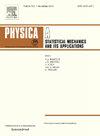From chaos to order: Evaluating behavior-driven road sign strategies in work zone management
IF 3.1
3区 物理与天体物理
Q2 PHYSICS, MULTIDISCIPLINARY
Physica A: Statistical Mechanics and its Applications
Pub Date : 2025-07-08
DOI:10.1016/j.physa.2025.130816
引用次数: 0
Abstract
Road construction significantly impacts traffic dynamics, often causing severe congestion, reduced speeds, and elevated accident risks due to lane closures and merging bottlenecks. This study employs a cellular automaton (CA) simulation to examine how changes in driver behavior, induced by different road signage strategies, influence traffic congestion patterns around work zones on multi-lane one-way roads. Three road sign strategies were analyzed: basic warning sign, detailed merging and speed regulation sign, and combined signs. Simulation results show that effective signage improves traffic conditions by promoting smoother lane changes and speed adjustments. The study further reveals that placing work zones in the middle lane (Lane 2) of a three-lane road tends to increase congestion unless appropriate signage is used. Moreover, analyses based on heatmaps, lane occupancy, and congestion metrics reveal the nonlinear and chaotic nature of traffic flow, showing that variations in driver behavior induced by different signage strategies lead to distinct congestion patterns. Unclear signage often leads to aggressive deceleration and merging, causing turbulent congestion waves and chaotic spillover effects. In contrast, advanced signage promotes orderly driving behavior, stabilizing traffic flow by balancing lane utilization and reducing nonlinear instabilities. These findings show the significant influence of signage-induced driver behavior on congestion patterns and provide practical insights for improving traffic management near work zones.
从混乱到有序:评估工作区域管理中行为驱动的路标策略
道路建设对交通动态产生了重大影响,经常造成严重的拥堵、速度降低以及由于车道关闭和合并瓶颈而导致的事故风险增加。本研究采用元胞自动机(CA)模拟来研究由不同道路标志策略引起的驾驶员行为变化如何影响多车道单行道工作区域周围的交通拥堵模式。分析了三种道路标志策略:基本警示标志、详细归并限速标志和组合标志。仿真结果表明,有效的标识通过促进更平稳的变道和速度调整来改善交通状况。该研究进一步表明,除非使用适当的标志,否则将工作区放在三车道道路的中间车道(车道2)往往会增加拥堵。此外,基于热图、车道占用率和拥堵指标的分析揭示了交通流的非线性和混沌性,表明不同标识策略引起的驾驶员行为的变化导致了不同的拥堵模式。不清晰的标志往往导致激进的减速和合并,造成汹涌的拥堵波和混乱的溢出效应。相比之下,先进的标识通过平衡车道利用率和减少非线性不稳定性来促进有序的驾驶行为,稳定交通流量。这些研究结果表明,标志诱导的驾驶员行为对交通拥堵模式有显著影响,为改善工作区域附近的交通管理提供了实用的见解。
本文章由计算机程序翻译,如有差异,请以英文原文为准。
求助全文
约1分钟内获得全文
求助全文
来源期刊
CiteScore
7.20
自引率
9.10%
发文量
852
审稿时长
6.6 months
期刊介绍:
Physica A: Statistical Mechanics and its Applications
Recognized by the European Physical Society
Physica A publishes research in the field of statistical mechanics and its applications.
Statistical mechanics sets out to explain the behaviour of macroscopic systems by studying the statistical properties of their microscopic constituents.
Applications of the techniques of statistical mechanics are widespread, and include: applications to physical systems such as solids, liquids and gases; applications to chemical and biological systems (colloids, interfaces, complex fluids, polymers and biopolymers, cell physics); and other interdisciplinary applications to for instance biological, economical and sociological systems.

 求助内容:
求助内容: 应助结果提醒方式:
应助结果提醒方式:


